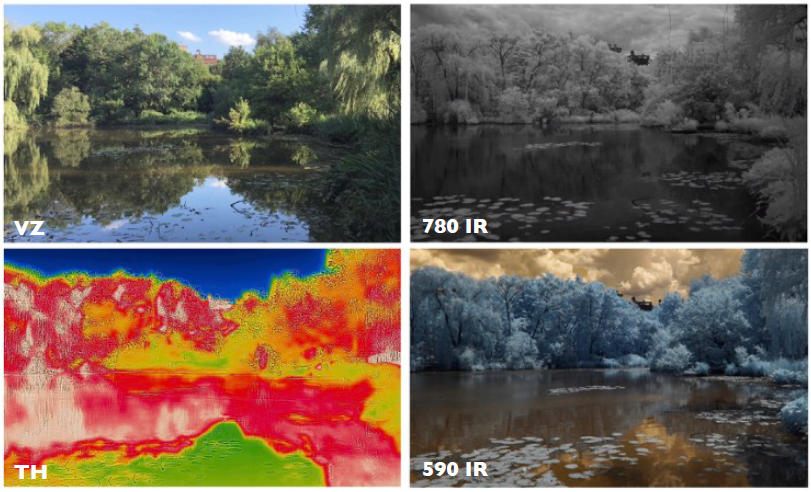↓ Download the Full Newsletter (PDF)
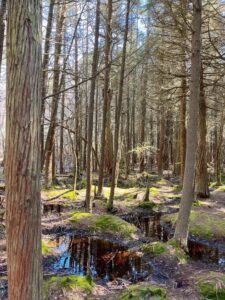
The Lost World of Brookline’s
Atlantic White Cedar Swamp
by Ann Frechette
LOOKING at Amory Park today with its well-manicured green fields, baseball diamond, tennis courts, walking paths and picnickers, it is hard to picture the Atlantic White Cedar Swamp that encompassed the land for millennia. Dense stands of ancient white cedar trees, stretching eighty feet into the sky, once dominated over thickets of highland blueberry, sweet pepperbush and thorny briers, home to white-tailed deer, cotton-tail rabbits, foxes, coyotes, spotted salamanders, and thousands of migrating birds.
North Brookline’s “Cedar Swamp” once extended from present-day Essex Street to the east, Pleasant Street to the west, Worthington Road to the north and Beacon Street to the south. It was massive. Troops stationed in Boston during the Revolutionary War trekked over the Muddy River just to see it. Nineteenth-century town planners described it as “bottomless,” a “dreaded hole and terror of youngsters” and “an almost impenetrable thicket of bushes and briers.”1 It had a presence in the letters that early settlers wrote to their distant relatives,2 and it was an engineering nightmare for the planners of town roads, water supply lines and sewers.3 The swamp washed out Beacon Street on multiple occasions,4 and it even swallowed the Wollaton Building, at 1070 Beacon Street, when it was initially built in 1897.5
The taming of the swamp is a too-often-told tale of how engineers prevailed. The Atlantic seaboard, from Maine to Georgia, once supported an estimated 500,000 acres of Atlantic White Cedars (Chamaecyparis thyoides). Wetlands enabled these slow-growing evergreen conifers to thrive. Cedar trees, untouched, can live for up to 1,000 years in a habitat of periodic flooding. In the wetlands that dominated the Atlantic Seaboard, layers upon layers of them grew, fell, rotted, and seeded new generations. Drainage of the wetlands resulted in significant losses, most notably in North Carolina and southern New Jersey. What remains now is a patchwork of isolated stands, only some of which are legally designated conservation lands.6

As elsewhere, Brookline’s Cedar Swamp was slowly but relentlessly drained and filled as settlers continued to arrive and the population expanded. White cedars, valued for their rot-resistant wood, became fence posts, support beams and shingles. Construction of the Mill Dam and the filling of the Back Bay prompted nineteenth-century mercantilist David Sears to buy Cedar Swamp lands as investment properties for his descendants whose names are now memorialized in the surrounding parks. When the estate of Anna Powell Sears Amory sold what was to become Amory Park to the Town of Brookline in 1903, the Brookline Historical Society lamented, “Shortly after that sale to the town, the owners of the rest of the estate began cutting down the trees and leveling the beautiful hill… little of its former beauty now remains.” By the time the adjacent plot became Hall’s Pond Sanctuary in 1975, it was a wasteland of muck, stormwater and garbage mentioned in the town records only with reference to mosquito management.7
Since 1976, the Friends of Hall’s Pond has been undertaking a restoration of the former Cedar Swamp lands. The land is hardly pristine, however. Standing white cedars are few and far between. The tidal floods that nourished the land were long ago diverted. The oily sheen to the pond water, consisting of tannins released from the rotting trees beneath the surface, is the only real evidence of the majestic cedars of the past. With town drainage projects, the installation of aerators, powered by solar panels, the sanctuary continues to remain a highly engineered habitat that requires regular maintenance to sustain its natural-like environment.
For a glimpse of what the land may once have looked like, one can visit other Atlantic White Cedar Swamps. In Massachusetts, they are in the Cape Cod National Seashore conservation lands near Marconi Beach in Wellfleet; the Mashpee Pine Barrens; Freetown-Fall River State Forest; Mass Audubon’s Great Cedar Swamp in Lakeville; Hockomock Swamp in Taunton; Atlantic White Cedar Swamp in Wilbraham; Acushnet Cedar Swamp State Reservation in New Bedford and the Atlantic White Cedar Swamp west of Lake Massapoag in Sharon. Legally protected but continuously threatened by changes in the surrounding environment, these landscapes are a testament to an almost-forgotten past.
1 Proceedings of the Third Annual Meeting of the Brookline Historical Society, January 27, 1904.
2 Mary Tilton Palmer, “A Historical Sketch of Muddy River,” The Chronicle, December 2, 1937, p. 16.
3 “Traffic Problem Confronts Town,” The Chronicle, January 22, 1925, p. 5; Annual Reports of the Town of Brookline, December 31, 1875.
4 “26 Ancient Trees to Go: Beacon Street Elms Will Topple in Drain Project,” The Chronicle, October 28, 1948, p. 2.
5 “A House Builded on the Sand,” The Suburban, August 31, 1900, p. 1.
6 A.D. Laderman, M. Brody, E. Pendleton, “The Ecology of Atlantic White Cedar Wetlands: A Community Profile,” U.S. Department of Interior, Fish and Wildlife Service, National Wetlands Center, July 1989.
7 “Proceedings of the Selectmen for the Current Week,” The Chronicle, November 17, 1900, p. 12; “Town Government,” The Chronicle, October
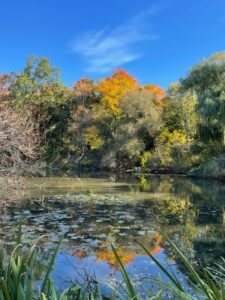
From the Co-Presidents
Ann Frechette and John Shreffler
OVER THE YEARS, the seasons at Hall’s Pond are similar, yet each year has its own signature. If 2022 was dry, 2023 was marked by abundant summer rains. The Sanctuary was exuberantly green. Our avian visitors cycled through the seasons, and we were blessed with families of Wood Ducks and Mallards. The Wood Duck family was the first one in a very long time and successfully added three new members to their community.
The tremendous increase in foot traffic through the Sanctuary that we observed during the first year of Covid continued unabated in 2023. More people than ever have discovered and are deriving delight from our jewel box of nature. Although Hall’s Pond is the smallest Conservation Sanctuary in Massachusetts, it is by far the most “intensively enjoyed”— the number of visitors has quadrupled over the last two years! The increase has placed a strain on the Boardwalk which is nearing the end of its service life and is scheduled for replacement next year.
Our Friends group continued its normal sequence of activities. Neil Gore, Thomas Michel, and Neil Calabro led a series of very well-attended guided bird walks during the Spring Migration from mid-April through the end of May. Special thanks to Fred Bouchard, who stepped back from the Bird Walks after decades of service.
We held our Spring Community Day in mid-May, which was very well attended. The Volunteer Maintenance Team, led by Priscilla Smith, began working in May and kept up steadily until the end of September. Their efforts are an essential component of the Sanctuary’s upkeep, and they were successful in beating back the constant challenge of invasive species. Our website continues to flourish and is constantly updated with new photo “Sightings” contributed by visitors and is well worth visiting: friendsofhallspond.org.
Our Annual Meeting was held in person in mid-June and featured guest speaker Susan Helms Daley. Her talk was entitled “Two Brookline Women’s Pivotal Role in the Bird Conservation Movement,” and it outlined how Harriet Hemenway and Minna Hall founded the Massachusetts Audubon Society. We said farewell to longtime Board Members Bob and Pat Schram, who have relocated. Both have given dedicated service and Bob served as Co-President during our recent turbulent time. Board Member Ann Frechette stepped forward and was elected to replace him.
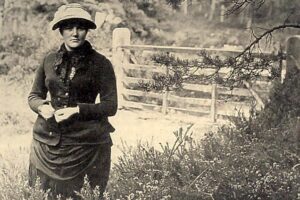
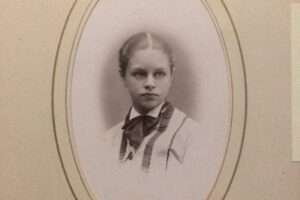
At season’s end, we had another very successful Community Planting and Cleanup Day. Co-President Emerita and expert horticulturalist Ellen Forrester brought a truckload of new plants funded by the Friends, which were successfully planted by our team.
The year saw two additions to the Sanctuary. We received approval from the Parks and Recreation Commission for a dedicated enclosed and curated bulletin board which has been installed outside the north gate by the Amory Playground picnic area. The bulletin board allows us to better inform the public
about our Sanctuary. We also saw the successful conclusion of our project to replace the very awkward solid cast iron gates with lighter more user-friendly replacements. Thank you to Brookline Greenspace Alliance for a matching grant through its Parks Initiative Program. The new gates were installed over the summer.
We carry on and are grateful for our other Officers: Jim Franco (Treasurer), and Priscilla Smith (Vice-President for Information Technology). Harry Breger continues to provide an artist’s touch in designing our newsletter. A special thanks to all our volunteers, too numerous to name here. Volunteers are an essential part of our team, and we always need and welcome more.
Your membership payments and generous gifts remain essential. We use them to keep up Hall’s Pond with new plantings and to help the Town with its projects. The Town’s budget remains tight, so your gifts and contributions are more important than ever.
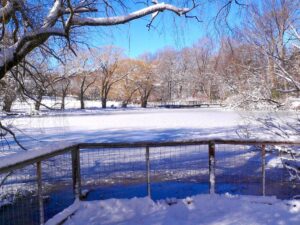
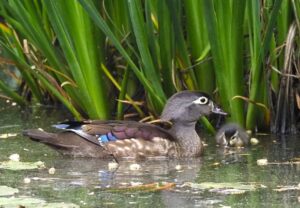
May 16, 2023. PHOTO CREDIT: Fran Perler
Wood Ducks Out Of the Box!
by Fred Bouchard
HALL’S POND had been waiting in the wings for years… its mostly empty nest-box half-hidden in the reeds had hosted the occasional fly-by-day Redwinged Blackbird or Tree Swallow, but not until recently its intended star tenants — Wood Ducks!
Its scientific name, assigned by Linnaeus, blends Greek and Roman: Aix [genus] was Aristotle’s term for “aquatic bird” and sponsa [species] is Latin for “betrothed, bride.” Thus: an “aquatic bird in festive dress.” Wood Ducks share the tiny Aix genus with Asia’s even more jazzily outfitted Mandarin Duck (Aix galericulata). Their historic wintering grounds in the Carolinas earned them the eponym Carolina Duck, and nicknames like Squealer and Acorn Duck.
Their preferred breeding habitat is eastern USA’s wooded swamps, shallow lakes, marshes, ponds. They love beaver-flooded woodlands like Bolton Flats, gravitate to wide tree holes and are lured by boxes, specifically engineered for these cavity nesters. Eggs hatch in 4 weeks, and precocious fledglings (yellow cheek, dark eye line) jump the nest in a day or two in response to their mother’s call. The hen leads them to feed themselves on aquatic insects, then plant materials; the ducklings are independent in two months.
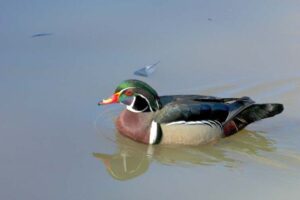
This year’s fluctuating gaggle was up to 7 by July. (See photos at friendsofhallspond.org > See and Share Sightings.) Because they’re so darn cute, woodies tend to elicit keen observation. “The Wood Duck family swims in open order; Mallards swim single file,” notes the Friends’ co-president John Shreffler. “They prefer the middle of the pond, and tend to avoid foraging on dry land.” Wayne Petersen of Mass Audubon notes: “I have watched Wood Ducks by the dozen flying to communal roosts in wooded swamps at night,” citing Burrage Pond WMA in Hanson and Ipswich River Wildlife Sanctuary in Topsfield. Watch for our Brookline woodies to return next April. A flock of them has recently been at Leverett Pond. If you can’t wait until spring, you might just spot wintering woodies there.
For more on avian natural history, please explore massaudubon.org
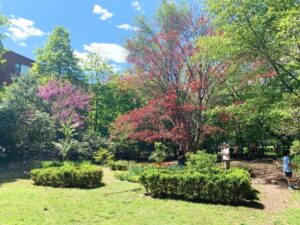
Volunteer Maintenance Team
by Priscilla Smith and Ann Frechette
THROUGHOUT the 2023 season, our loyal band of regular volunteers removed invasives, maintained the formal gardens, cleaned up the trash and planted new plants in the Sanctuary. Thank you to Andrea Ignatoff, Janet Wynn, Fran Perler, Ann Frechette, Priscilla Smith, John Shreffler, Sharon Hessey, and Jim Perrin. We also welcomed several new volunteers, including Clara Bing, William Jones, and Mayim Baron. The copious amounts of rain that fell throughout the summer brought out a lot of greenery and the Sanctuary looks amazing! Thank you also to everyone who joined us for Fall Community Day. We had a great time and we appreciate your work.
As we plan for the 2024 season, we welcome new members to join us. The team is active from early spring through late fall in keeping the formal garden attractive, controlling the growth of invasive species, planting native species and removing trash. The team complements the work done during the spring and fall Community Days. All of the work done by the volunteers is consistent with the maintenance plan approved by the Conservation Commission in 2010.
Participation on the team is an excellent way to get outdoors, learn about nurturing a nature preserve in an urban setting, and appreciate the beauty of the Sanctuary. The twice-monthly work sessions are scheduled on mornings that are most convenient for members of the team. Work sessions are announced a week or more in advance. Members come only as often as their schedules permit. For more information, contact volunteer coordinator, Priscilla Smith. Her e-mail address is pjs00002000@yahoo.com or call 617-571-4792.

Me and Merlin
by Neil Gore
TECHNOLOGICALLY speaking, I have now been dragged, kicking and screaming, into the 21st Century. I am a notorious “late adapter” of computer and phone technology. But increasingly, I love the new experience, once I appreciate it for what it is: a new and different experience of reality, with all the associated positives and negatives.
For some time now, more experienced (i.e. younger) birding colleagues have been preaching the virtues and value and excitement of the birding app “Merlin Bird ID.” I of course resisted: I’m quite content carrying my print field guides—Peterson and Sibley—with me into the field. After all, it only takes a few moments to look up something, and something else related.
But how fun it is to take a walk in Hall’s Pond, open the app, and click on “Sound ID.” As Merlin records sounds, it lists all birdcalls it can identify, highlighting each as they occur. You can replay the recordings, again highlighting each call as they sound. Merlin contains other functions such as “Step By Step ID” which names species based on your answers to questions regarding colors, size, terrain, and such. As I sort out what’s likely and unlikely, it’s like I’m a detective, zeroing in on the likely suspects.

I’ve found that Merlin is the gateway drug for friends who have only the most casual interest in birding. Now they are hooked! I am very impressed that many of my friends and acquaintances who have had little birding experience, are now very enthusiastic and are learning quickly. It is an extra pleasure to see them so excited.
Hall’s Pond is a great place for Merlin. It is very useful in small group discussions about bird ID, and offers overlooked possibilities. It is not perfect, of course, but if you have your phone’s Location setting on, and/or if you install their Bird Pack for your vicinity, Sound ID can be quite accurate. I imagine it is most useful in the spring, when birds are singing and vocalizing more.
There are also important issues. It increases the temptation to play back bird calls, so as to lure in the birds for better viewing. This is often disruptive to birds going about their daily lives, trying to find food, mates, and marking off territories; and this among other of our human behavior can be undesirable if not downright unethical. And I can imagine it may increase one’s focus solely on bird identification, rather than appreciating the entire birding experience.
But on the whole, Merlin, along with other improvements such as digital photography, and detailed online reports of daily sightings (www.ebird.org), have added new dimensions and greater depth to a birding stroll around Hall’s Pond. It’s all free — plus it sends important data back to the Cornell Lab of Ornithology!

A Note from the Town
by Tom Brady, Brookline Conservation Administrator
AS WE wind down the fall season and begin our transition into winter, it is a perfect time to reflect on what has been accomplished and what needs and issues will need to be addressed in 2024.
2023 has been a vibrant and busy year for the Sanctuary. The Friends of Hall’s Pond has had two enormously successful workdays, and Priscilla and her crew have continued to provide a tremendous amount of care and upkeep to the Sanctuary as the season has progressed. These efforts are critically important in our goal to control the ever-advancing invasive species currently present on site. The weather patterns in 2023 certainly had impacts in the Sanctuary. All aspects of the rainfall — frequency, duration, intensity, and amounts — were a bit more than we have had historically. The impacts from these changing patterns included rapid expansion of invasives, fungal and disease problems on the plants, pathway washouts, and temporary closures of the boardwalks to reset them after three separate rain events.
As is the normal practice, the major maintenance and upkeep of the Sanctuary has continued throughout the year using Town staff and contracted services. Items addressed include tree pruning and removal, regular mowing of the formal garden areas, as well as maintenance of the sediment forebay which protects the Pond from harmful sediment.
With much gratitude, I extend my thanks to the Friends and Boston Greenspace Alliance for partnering with the Town to fund the replacement of the metal entrance gates. The newly installed gates were fabricated using the original plans and specifications to ensure we matched the design intent. The biggest difference is the weight of the material, which has cut the overall weight of the gates by more than 60%, this change will allow users to more easily access the Sanctuary and reduce wear and tear of the hinges as well.
The recent Fall workday was a resounding success. There were many competing events going on across the community that particular day and yet when I arrived, the Sanctuary was full of people working to leave things better than when they arrived! The number of new faces and first-time attendees was striking, and I think speaks volumes to the effective efforts of the Friends in keeping the Sanctuary at the forefront of peoples’ thoughts.
I invite you to visit the Sanctuary this autumn and take a nice stroll through this natural gem and stop and find your own moment of discovery! Enjoy this Fall season, and bundle up and enjoy the sights and sounds of the winter season as well! I look forward to seeing all of you at the 2024 spring workday.
 Is it Art, Science … or Both?
Is it Art, Science … or Both?
by David Chalpin
I believe it is the latter. As can be seen from these multispectral photographs taken in Hall’s Pond Sanctuary (HPS) in 2019 & 2020, my intention is to depict what lies within both realms. Since 2018, during various times of the year, I’ve taken a variety of photographs of HPS, not only in visible light, but also near-Infrared (IR), color IR, Ultraviolet (UV), color UV, and Thermal (which is a portion of the far end of the Infrared spectrum). These montages are two examples.
Legend: All Infrared filters used in this presentation are of the high bandpass variety. Specifically, the numeric value, X, expressed in nanometers, indicates that light with wavelengths greater than X, up to ~1150 nm, are passed through the filter to the camera’s image sensor.
VZ (= Visible light only, wavelength range of ~400–700 nm); TH (= Thermal, wavelength range of 9,000–14,000 nm).